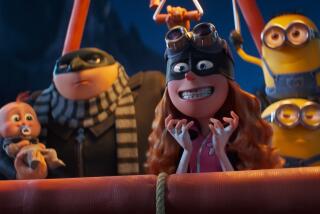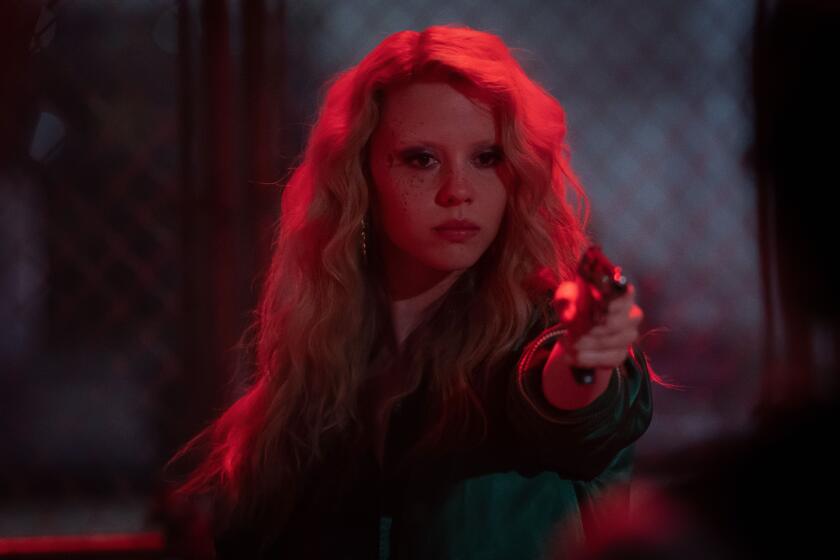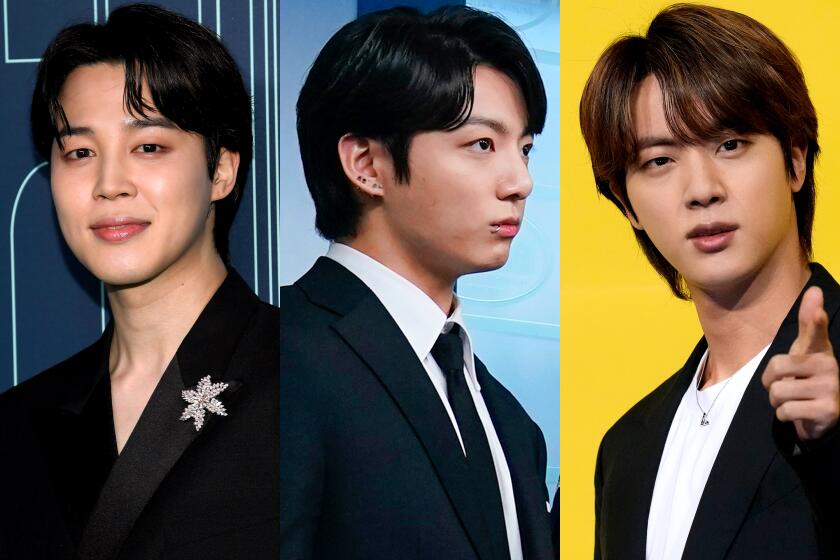Comic’s Legacy: ‘Bebe’s Kids’ : Robin Harris Lives On in New Animated Feature
Comedian Robin Harris was on the verge of a major breakthrough when he died of heart failure two years ago at 36 in a Chicago hotel room. The public at large knew him only from a couple of small film roles, principally his oracular Sweet Dick Willie in “Do the Right Thing,” but in the Los Angeles African-American community he was a sensation, one of the hottest club secrets in black America.
When Harris took the stage at the Crenshaw District’s Comedy Act Theater, he would see a number of the Los Angeles Lakers cooling out after a night at the Forum (as well as other NBA players from around the league), or Mike Tyson (when he was champ), or Spike Lee, or Branford Marsalis, all of whom at one time or another proudly withstood Harris’ mock show of surreal, withering scorn (“Who you think that is sittin’ over there,” he once said of Lee, “Mr. Magoo?”). To them and the rest of the audience, which doubled over with laughter when one of his zingers curved low and inside, he was family.
Harris left few career tangibles behind. There were the film clips, and a single CD recording of his live performance, “Bebe’s Kids.” But he did leave an unforgettable spirit, and “Bebe’s Kids” has now been converted into a feature-length animated film, opening nationwide Friday.
It’s the first full-length black feature in animation history, and is distributed through a joint venture between Hyperion Animation and Paramount. Warrington and Reginald Hudlin, who are the principal creative forces behind “Boomerang,” are also signed on with this one. Warrington Hudlin is executive producer. Reginald Hudlin is executive co-producer, and as screenwriter has fleshed out what was originally a mere sketch in which Harris, as a surrogate dad, has to shepherd a comically horrific bunch of kids through an afternoon at an amusement park.
In a summer in which the idea of opportunity--either lost or hoped-for--is in the air, “Bebe’s Kids” offers a number of relative unknowns a leg up in their careers. Chief among them is Bruce Smith, who at 30 is directing his first feature.
“Every studio has its own style, whether it’s Disney, Warner Bros. or the old Tex Avery shorts,” Smith said in Hyperion’s Glendale studio. “The same is true with ‘Roger Rabbit,’ ‘Beauty and the Beast’ and ‘The Little Mermaid.’ ‘Bebe’s Kids’ is very different, and not only because it’s an African-American film.”
Smith said that Tom Wilhite, president of Hyperion, brought him a book dating back to the Harlem renaissance. “There was a different sense about color and its roots which was very Afro-centric, full of reddish-browns, deep greens and blues. There’s nothing quite like it.”
Smith is a tall, soft-spoken man who seems collected in a spirit of unusual tranquillity, perhaps developed out of the professional animator’s need for deep reservoirs of patience. He drew cartoons for the school paper at George Washington High in Los Angeles before studying at CalArts, and then went to work for a couple of small animation studios, gaining the experience that eventually helped him hire on as one of the animators for “Who Framed Roger Rabbit.” He also worked on “Rock-a-Doodle” and an earlier Hyperion feature, “Rover Dangerfield.”
“In ‘Bebe’s Kids,’ I designed the characters and other animators gave me ideas on how they should move,” Smith said, by way of explaining what a director in this instance does. “Then I laid down the foundation on how the feature will look. If you compare the process to live-action features, you have story-board artists equivalent to cinematographers--they give you your shots. You have layout artists who design the sets, then background artists who produce the mood and lighting and fill out the color. Then I have to direct the voices, which you do before you start any characters. It’s very precise. You have what’s called an X-sheet, which shows how long it takes a person to say a word, so that you can make the drawing fit.
“Then there’s the scoring of the film, which in this case involves a lot of rhythm & blues and rap. (The character representing) Robin does a blues rap number, and a love song. It’s a very eclectic mix.”
Method and technique aside, what Smith hopes for most out of “Bebe’s Kids” is that it will convey the truth of real experience.
“Comedy not only allows you to laugh at yourself, you can analyze too,” Smith said. “Comics do ask questions, and make observations. When I was a kid, I grew up with the kind of humor Robin had, talkin’ about someone’s feet, or like the fat lady who goes into Lane Bryant and says, ‘I’d like to see a dress that’ll fit me’ and the saleslady says, ‘Me too.’ I can remember doubling up in tears when someone’s roasting someone else. The humor of the street was all we used to do as kids.
“I had to bring everything I know to this. I could relate to what Robin went through with his ex-wife, girlfriends, kids. I have three kids. When the riots broke, out I was driving with them through the intersection at La Brea and Rodeo. We saw people looting a bank and rocking a truck. That scares you. You’ve got to be able to ground your kids, to say, ‘See this? Don’t do it.’ And we need role models. What happens when a black entertainer starts to get hot--even a comedian? The moviemakers give him a gun. Eddie Murphy understands this.
“There comes a point when everyone’s gonna have to take responsibility. That’s what Robin does in ‘Bebe’s Kids.’ He may not like them. They get on his nerves. But he realizes that they need someone to guide them.”
Animators Jamie Lopez and Lennie Graves are also mindful of the need for authenticity in dealing with a social topic, even if it’s in a cartoon.
“Typically, animated films research other animated films for style and design,” Graves said. “We went to live-action films reaching back to early in the century to study movement and find out how much is generic and how much is specific. There are lots of variations even within type. For instance, Robin in the movie is 40, which means his physical attitude toward things is a lot different from hip-hop kids.
“In my opinion, everybody in the black community knows everything about everyone else,” Graves added. “The young know about the old, men know about women, and vice versa. Frankness is very common. But it’s a difficult world for whites to empathize with. In this film we broke a lot of barriers. We tried to create a climate of empathy instead of a climate of opinion.”
“I didn’t know about Robin or about black culture, so it was scary at first,” Lopez said. “This is a film where you see kids throwing signs. I wondered if I should be working on it at all. But to do animation you have to understand feelings. Eventually I began to understand. This is definitely not birds and bunnies.”
Wilhite, 39, was head of film production at Disney before Michael Eisner and Jeffrey Katzenberg joined the company, and is producer for “Bebe’s Kids,” which he thinks holds relevance for the ‘90s--particularly in light of recent political claims on what constitutes “family values” and what doesn’t.
“I think the depiction of family that came out of the Reagan years is an out-of-touch portrait,” Wilhite said. “Non-conventional families can be just as powerful as conventional families in the shaping of an adult.
“ ‘Bebe’s Kids’ is an appealing story of this put-upon single guy who spends a day with the kids of his girlfriend and another woman who’s not around. Out of this amalgamation they form a spontaneous nuclear family. Whether he likes it or not, he has to take responsibility.
“This is a subject that’s never been dealt with before in an animated feature,” Wilhite said. “Aside from the message, what we’ve tried to do is create a film where the subject influences the design--that’s why we looked so long at African-American art. When we formed this company in the mid-’80s, the industry was gearing up for the baby-boomlet generation, and when we made ‘The Brave Little Toaster,’ animation was a distinctly non-chic business. Suddenly it’s become a new discovery. I think there’s a chance to do something exciting if you think of it as filmmaking and not baby-sitting.”
There are people who think that, had he lived, Robin Harris may have exerted a calming influence during Los Angeles’ recent civil unrest. Certainly he was fearless, he spoke the language of the street, and there wasn’t anyone he couldn’t disarm with a joke. If “Bebe’s Kids” achieves what its creators have set out to do, it could help foster the climate of understanding most people realize is essential in the attempt to rebuild. And Harris himself will have earned a few more rounds of laughs.
More to Read
The biggest entertainment stories
Get our big stories about Hollywood, film, television, music, arts, culture and more right in your inbox as soon as they publish.
You may occasionally receive promotional content from the Los Angeles Times.






